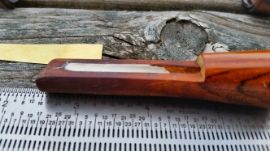I've been experimenting a bit the last few days with the impact of tonechannel slope on performance of reelfoot calls, and though I'd share as this may help someone... or provide a place for others to share their experience and learnings.
The initial setup is a reelfoot insert with a flat (no slope) 1/4" tone channel. The reed was held constant for this experiment, to isolate the impact of changes to the tone channel.
Baseline - flat tone channel (full depth)
Tuning the reed was a challenge, and I was never able to achieve the full range I would normally want. At a low pressure quack, I had to tune the reed to a very low somewhat flat pitch to get any high pressure performance - but when applying pressure in a hail or highball, pitch was way too high and squealy.
Test 1 - approximate slope by using modeling clay in the tone channel
Little by little, I added modeling clay into the forward end of the tone channel and used a 1/4" dowel to shape it into a gradual slope from the bottom of the original channel. Even with just a small bit of clay sloping to about halfway back towards the wedge, sound performance imoroved with slightly higher pitched quacks and noticeably less squeal at pressure. I continued adding clay and slope until I had a fairly consistent slope from roughly the front of the wedge to the forward end of the tone channel. At the forward end of the tone channel, depth from top of clay to tone board was about 1/16". At this point, the call was performing best, with a pretty good range and handling high pressure well without lockup or squeal.
My hypothesis at this point was that slope was a critical factor to getting top performance and range out of a reelfoot call... but the possibility existed that the improvement resulted not from slope but simply from the smaller volume capacity tone channel, so I needed to try to test for that, too.
Test 2 - Same amount of clay, but flat (no slope)
To test volume displacement without slope impact, I simply respread the clay from Test 1 flatly along the bottom of the tone channel, from tip of the channel to the back of the wedge. In other words, Test 2 should have had the same tone channel volume capacity as Test 2 (and less than baseline), but no slope. While this setup performed better than baseline, it clearly had less range than Test 1 and got squealy again with pressure.
My conclusion is that slope is indeed important to getting a full range, highly performing reelfoot. I've included links below to soundfiles so you can hear the differences in the setups yourself, as well as a pic of the tone channel with the clay slope. A couple footnotes are in order. First, the soft clay certainly has a different impact on sound than wood, so a similarly sloped wood tone channel would certainly sound different than these files. I wasnt going for perfect sound, rather just trying to test relative sound from different setups. Second is a reminder that the reed was held constant in these sound files. Tweaks to curve, shape, thickness, etc. may have made any of the 3 setups better (or worse).
I hope this helps others, and hope others will add to these observations with their own.
Baseline
https://www.dropbox.com/s/as8ap16ui2fktsn/reelfoot-flatTC.m4aTest 1
https://www.dropbox.com/s/5gpk9pfc06rdxo7/reelfoot-clayslope.m4aTest 2
https://www.dropbox.com/s/8dfn15pjokqyvxa/reelfoot-clayflat.m4a